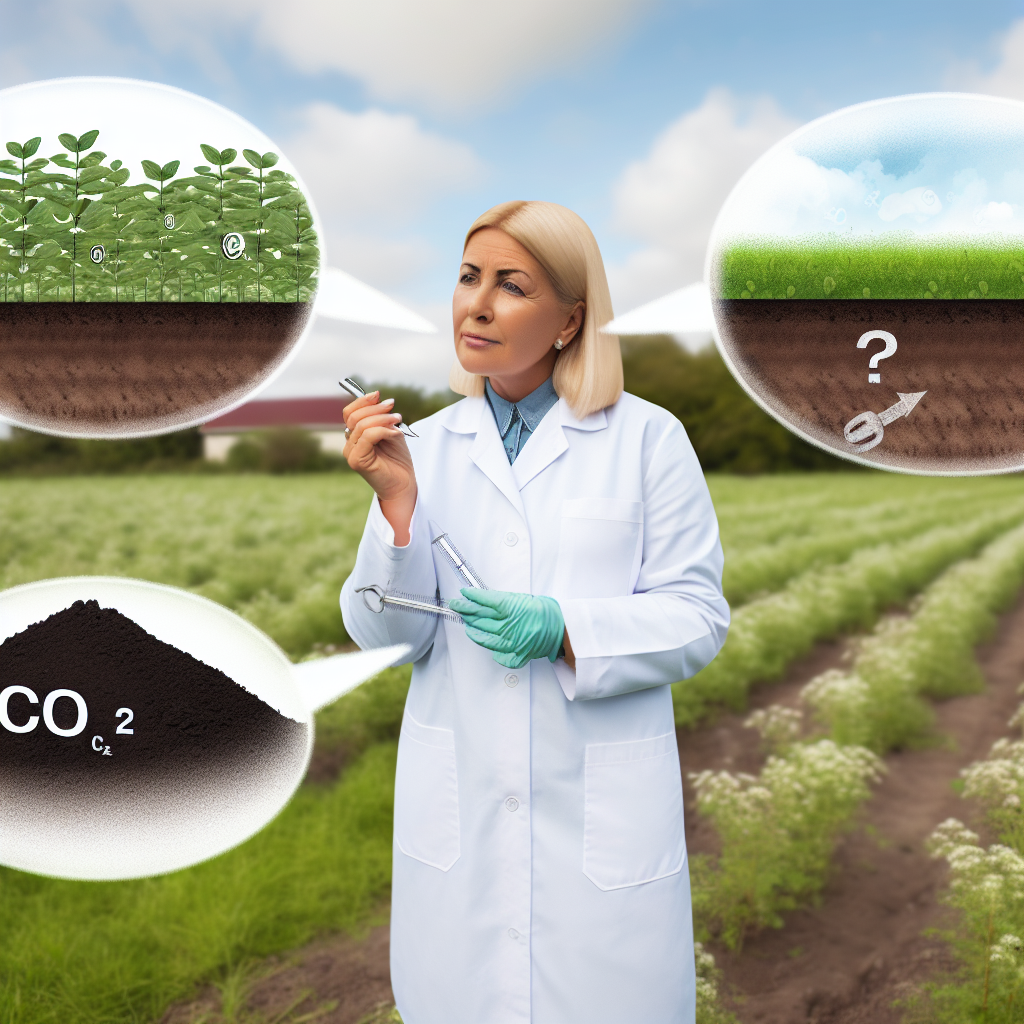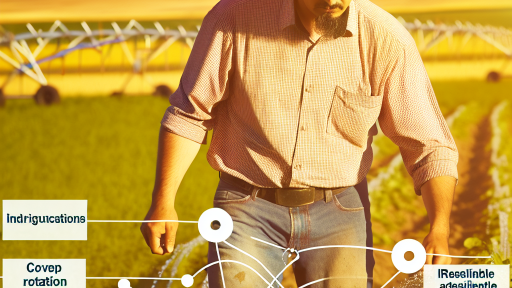Introduction to Soil Health and Carbon Sequestration
Soil health plays a crucial role in agricultural productivity.
Healthy soil supports robust crop growth and resilience against pests.
Furthermore, it enhances water retention and nutrient availability.
On the other hand, soil degradation jeopardizes these benefits.
It leads to reduced yields and increased erosion rates.
Hence, understanding how to maintain soil health is vital for sustainability.
Understanding Carbon Sequestration
Carbon sequestration refers to the process of capturing and storing atmospheric carbon dioxide.
It serves as a natural mechanism to mitigate climate change effects.
Through photosynthesis, plants absorb CO2, storing carbon in their biomass.
Soil also acts as a reservoir for carbon, storing it in organic matter.
This process not only sequesters carbon but also improves soil structure.
Consequently, it enhances soil fertility and promotes biodiversity.
The Interconnection Between Soil Health and Carbon Sequestration
Healthy soils increase carbon storage capacity significantly.
Practices that promote soil health, such as cover cropping, enhance this effect.
Additionally, no-till farming protects soil structure and reduces erosion.
Transform Your Agribusiness
Unlock your farm's potential with expert advice tailored to your needs. Get actionable steps that drive real results.
Get StartedThese methods foster a cycle of carbon capture and improved soil health.
Moreover, healthier soils can better withstand extreme weather conditions.
Thus, investing in soil health translates to enhanced carbon sequestration efforts.
Understanding the Mechanisms of Carbon Sequestration in Soil
Defining Carbon Sequestration
Carbon sequestration refers to the process of capturing and storing atmospheric carbon dioxide.
This natural process helps mitigate climate change by reducing greenhouse gases in the atmosphere.
Soil plays a crucial role in carbon sequestration through various mechanisms.
SoiOrganic Matter Formation
One key mechanism is the formation of soil organic matter.
This occurs when plant residues and microbial biomass decompose.
During decomposition, carbon from these materials becomes part of the soil structure.
Consequently, healthy soil can store significant amounts of carbon over time.
Microbial Activity and Carbon Stabilization
Microbial activity significantly influences carbon storage in the soil.
Microorganisms break down organic matter, releasing carbon dioxide back into the atmosphere.
However, they also convert some carbon into stable forms that remain in the soil.
This stabilization occurs through physical, chemical, and biological processes.
Stable carbon compounds can persist in the soil for decades or even centuries.
The Role of Roots in Carbon Sequestration
Plant roots also contribute to carbon sequestration.
As roots grow and die, they release carbon into the soil.
This carbon becomes part of the soil organic matter.
Furthermore, roots support the microbial community, enhancing decomposition and stabilization processes.
Influence of Soil Texture and Structure
Soil texture and structure significantly impact carbon sequestration capabilities.
Soils with good structure enhance water retention and aeration.
These characteristics encourage root growth and microbial activity.
As a result, carbon can be sequestered more effectively.
Effective Agricultural Practices
Practices such as cover cropping and reduced tillage improve soil health.
Showcase Your Farming Business
Publish your professional farming services profile on our blog for a one-time fee of $200 and reach a dedicated audience of farmers and agribusiness owners.
Publish Your ProfileThese methods promote organic matter accumulation and enhance carbon storage.
Additionally, integrating perennial crops can significantly increase soil carbon levels.
Ultimately, these practices lead to more resilient ecosystems and agricultural productivity.
Importance of Soil Organic Matter for Carbon Storage
Role of Soil Organic Matter
Soyl organic matter plays a vital role in carbon storage.
It acts as a reservoir for carbon, helping to mitigate climate change.
This organic matter improves soil structure and fertility.
Moreover, it enhances water retention in soils.
Farmers benefit from better plant growth due to enriched soils.
Soil Carbon Sequestration Process
Carbon sequestration in soil involves multiple processes.
These processes convert atmospheric carbon dioxide into organic forms.
Plants absorb CO2 during photosynthesis and transfer it to the soil.
Microorganisms decompose organic materials, resulting in soil carbon buildup.
Impacts of Soil Organic Matter on Ecosystems
Healthy soil ecosystems provide numerous benefits.
They enhance biodiversity by supporting diverse organisms.
Furthermore, these ecosystems improve resilience against erosion.
Healthy soils also filter water and reduce runoff.
Thus, they contribute to overall environmental health.
Methods to Enhance Soil Organic Matter
- Cover cropping helps add organic material to the soil.
- Composting improves soil fertility and structure.
- No-till farming preserves existing organic matter.
- Crop rotation enhances soil health and reduces pests.
Farmers can adopt these methods to improve soil organic matter levels.
Utilizing these strategies promotes sustainable agricultural practices.
You Might Also Like: How Farmers Are Battling Heatwaves and Drought with Innovation
Practices for Enhancing Carbon Sequestration in Agriculture
Understanding Carbon Sequestration
Carbon sequestration refers to the process of capturing and storing atmospheric carbon dioxide.
This process plays a critical role in mitigating climate change.
By enhancing soil health, carbon sequestration can improve agricultural productivity.
Promoting Organic Farming
Organic farming practices enhance soil’s organic matter content.
The use of compost and cover crops increases carbon storage in the soil.
Farmers should avoid synthetic fertilizers, which can deplete soil health.
Moreover, crop rotation helps maintain ecological balance and prevents soil degradation.
Implementing Agroforestry
Agroforestry integrates trees and shrubs into agricultural landscapes.
This practice captures more carbon while providing additional benefits.
Trees improve biodiversity and enhance soil structure.
Moreover, they can provide shade and wind protection for crops.
Utilizing No-Till Farming
No-till farming minimizes soil disturbance, preserving carbon stocks.
This method enhances soil structure and health over time.
Additionally, it reduces erosion and improves water retention.
Farmers implementing no-till practices often report higher yields.
Incorporating Cover Crops
Cover crops protect soil between main crop seasons.
They reduce erosion and improve soil organic matter content.
Leguminous cover crops fix nitrogen, benefiting subsequent crops.
Moreover, they enhance soil microbial activity, which supports carbon sequestration.
Enhancing Crop Diversity
Diverse cropping systems improve resilience and soil health.
Showcase Your Farming Business
Publish your professional farming services profile on our blog for a one-time fee of $200 and reach a dedicated audience of farmers and agribusiness owners.
Publish Your ProfileBy incorporating a variety of plants, farmers can optimize nutrient cycling.
Crop rotation disrupts pest and disease cycles, enhancing productivity.
This diversity also increases the soil’s capacity to store carbon.
Restoring Degraded Lands
Restoration of degraded lands contributes to carbon sequestration efforts.
Implementing sustainable land management practices is crucial.
These practices include reforestation and restoring native vegetation.
Healthy ecosystems enhance carbon uptake in the long term.
Utilizing Biochar
Biochar is a charcoal-like substance that improves soil health.
This amendment retains soil moisture and nutrients, benefiting plant growth.
Biochar can sequester carbon for centuries, making it a powerful tool.
Farmers should consider incorporating biochar into their soils.
Discover More: Climate-Smart Agriculture to Combat Greenhouse Gases
Role of Cover Crops in Improving Soil Health and Sequestering Carbon
Improvement of Soil Structure
Cover crops enhance soil structure significantly.
They increase soil aggregation and porosity.
This improvement promotes better water infiltration.
Moreover, it reduces surface runoff, helping to prevent erosion.
Enhancement of Nutrient Content
Cover crops contribute to soil fertility through several mechanisms.
They capture residual nutrients left in the soil.
These crops can fix atmospheric nitrogen, enhancing soil nitrogen levels.
This process reduces the need for synthetic fertilizers.
Carbon Sequestration Mechanism
Cover crops play a crucial role in carbon sequestration.
They capture carbon dioxide through photosynthesis.
Additionally, organic matter from these crops becomes stable carbon in the soil.
This process helps mitigate climate change effectively.
Support for Soil Microbial Communities
Cover crops foster diverse microbial activity in the soil.
This diversity promotes microbial health and enhances nutrient cycling.
Healthy microbial communities contribute to better soil structure.
As a result, they help in improving overall soil resilience.
Weed Suppression and Pest Management
Cover crops suppress weed growth effectively.
They cover the soil, preventing sunlight from reaching weed seeds.
Furthermore, certain cover crops can deter pests and diseases.
This natural pest management reduces dependency on chemical pesticides.
Implementation Strategies for Farmers
Farmers can select appropriate cover crops based on their specific needs.
Choosing native species often maximizes the benefits.
Implementing cover crops during off-seasons ensures soil is never bare.
This strategy enhances soil protection and health year-round.
See Related Content: Top Carbon Sequestration Techniques for Farmers
Impact of Reduced Tillage on Soil Carbon Dynamics
Understanding Reduced Tillage
Reduced tillage involves minimizing soil disturbance during farming.
This practice changes the way farmers manage their land.
As a result, it has significant effects on soil health.
Showcase Your Farming Business
Publish your professional farming services profile on our blog for a one-time fee of $200 and reach a dedicated audience of farmers and agribusiness owners.
Publish Your ProfileSoil Carbon Sequestration Mechanism
Soin carbon sequestration refers to the storage of carbon in soil.
Reduced tillage promotes this process effectively.
Less disturbance allows carbon to accumulate over time.
This change enhances the soil’s organic matter content.
Advantages of Reduced Tillage
Reduced tillage provides numerous benefits for soil carbon dynamics.
- It minimizes soil erosion and degradation.
- Organic matter remains intact, promoting microbial activity.
- Carbon remains in the soil instead of being released into the atmosphere.
- This practice enhances nutrient availability for crops.
Challenges to Adoption
Despite its benefits, some farmers hesitate to adopt reduced tillage.
Initial costs can deter many from making the switch.
Additionally, changing traditional practices requires time and effort.
Farmers may also worry about weed management and crop yields.
Successful Implementation Strategies
To overcome challenges, farmers can follow specific strategies.
- Education on reduced tillage benefits can encourage adoption.
- Supporting programs can help mitigate initial expenses.
- Networking with experienced farmers can provide valuable insights.
Collaboration with agricultural experts can enhance knowledge sharing.
By employing these strategies, farmers can successfully implement reduced tillage.
Explore Further: Adapting to Changing Weather Patterns: Climate-Smart Farming Solutions

Benefits of Agroforestry for Soil Health and Carbon Capture
Improved Soil Structure
Agroforestry enhances soil structure significantly.
Trees and shrubs add organic matter to the soil.
This organic matter improves cohesion among soil particles.
As a result, soil becomes more resilient to erosion.
Properly structured soil retains moisture more effectively.
Enhanced Nutrient Cycling
Agroforestry systems promote better nutrient cycling.
Tree roots access nutrients deeper in the soil.
Leaves and organic matter enrich the upper layers when they decompose.
This natural process reduces the need for synthetic fertilizers.
Moreover, diverse root systems enhance overall soil fertility.
Increased Carbon Sequestration
Agroforestry practices significantly increase carbon sequestration.
Trees capture carbon dioxide from the atmosphere.
This carbon gets stored in biomass and the soil.
Incorporating trees in agricultural landscapes contributes to climate change mitigation.
Consequently, farmers can benefit economically from carbon credits.
Biodiversity Enhancement
Agroforestry promotes biodiversity on farms.
This practice creates habitats for various species.
Increased biodiversity leads to natural pest control.
As a result, agroforestry systems become more resilient to pests and diseases.
This diversity also supports pollinators, benefiting crop yields.
Reduced Soil Compaction
Agroforestry reduces soil compaction effectively.
Tree roots create channels in the soil.
These channels enhance water infiltration and root penetration.
Consequently, plants enjoy better access to nutrients and water.
Improved soil aeration benefits microbial activity.
Microclimate Regulation
Agroforestry systems help regulate microclimates.
Trees provide shade and reduce temperature fluctuations.
Showcase Your Farming Business
Publish your professional farming services profile on our blog for a one-time fee of $200 and reach a dedicated audience of farmers and agribusiness owners.
Publish Your ProfileThis moderation benefits crops and livestock alike.
As a result, agroforestry enhances overall farm productivity.
Farmers can achieve better yields even during extreme weather events.
Measuring and Monitoring Soil Carbon Levels Over Time
The Importance of Soil Carbon Measurement
Measuring soil carbon levels is crucial for understanding soil health.
Soyl carbon contributes to fertility and water retention.
Moreover, it plays a vital role in carbon sequestration efforts.
Accurate measurements inform effective land management practices.
Methods for Measuring Soil Carbon
Various methods exist to measure soil carbon levels.
One popular method is the use of soil sampling and laboratory analysis.
This approach provides precise data on carbon stocks.
Alternatively, field-based sensors can offer real-time measurements.
These sensors are increasingly popular due to their convenience.
Monitoring Techniques Over Time
Consistent monitoring is essential for tracking changes in soil carbon levels.
Implementing a long-term monitoring program is advisable.
This program should include repeated soil sampling at specific intervals.
Regular monitoring assists in understanding trends and evaluating practices.
Challenges in Measuring Soil Carbon
Measuring soil carbon poses several challenges.
Site variability can affect consistency in results.
Additionally, different land management techniques may skew measurements.
Recognizing these challenges is crucial for accurate assessments.
The Role of Technology in Soil Carbon Monitoring
Advancements in technology have transformed soil carbon measurement.
Remote sensing and digital tools enhance data collection efficiency.
These technologies also improve our ability to analyze large datasets.
Consequently, they aid farmers in making informed decisions.
Engaging Stakeholders in Soil Carbon Monitoring
Successful monitoring requires collaboration among stakeholders.
Farmers, scientists, and policymakers must work together.
Sharing knowledge promotes better understanding of soil carbon dynamics.
This cooperation can drive meaningful change in agricultural practices.
Challenges and Limitations in Implementing Carbon Sequestration Practices
Financial Barriers
Implementing carbon sequestration often requires significant upfront investment.
Farmers may struggle to afford innovative technologies and practices.
Additionally, funding and financial incentives may be limited or unavailable.
This lack of financial support can hinder widespread adoption.
Knowledge and Education Gaps
Many farmers lack adequate understanding of carbon sequestration techniques.
Educational resources and training programs are often insufficient.
Without proper guidance, farmers may be hesitant to adopt new practices.
Moreover, misinformation can lead to skepticism about effectiveness.
Soil Type and Climate Limitations
Not all soil types are suitable for carbon sequestration methods.
Some regions face climate conditions that restrict effective implementation.
For example, arid regions may struggle with moisture retention.
Thus, localized approaches are often necessary for success.
Showcase Your Farming Business
Publish your professional farming services profile on our blog for a one-time fee of $200 and reach a dedicated audience of farmers and agribusiness owners.
Publish Your ProfileRegulatory and Policy Challenges
Government policies can significantly impact carbon sequestration efforts.
Ambiguous regulations may deter farmers from participating.
Additionally, inconsistent policies across regions create confusion.
This inconsistency can thwart long-term project planning and investment.
Measurement and Verification Issues
Accurately measuring carbon sequestration can be complex and challenging.
Inconsistent methodologies may lead to unreliable data.
Also, establishing a verified carbon credit market remains difficult.
This lack of credibility can dissuade potential investors.
Market Demand Fluctuations
Demand for carbon credits can change unpredictably.
Such volatility can impact farmers’ willingness to invest in practices.
Consequently, stable markets are essential for maintaining interest.
Farmers require reassurance that their efforts will be rewarded.
Policy Implications and Support for Carbon Sequestration in Agriculture
Importance of Policy Frameworks
A robust policy framework is crucial for advancing carbon sequestration in agriculture.
Policies can encourage farmers to adopt regenerative practices.
Consequently, these measures will help capture and store carbon in soil.
Government Incentives
Financial incentives play a vital role in fostering sustainable agriculture.
Programs like conservation grants empower farmers to implement carbon-friendly practices.
For instance, the Green Climate Fund supports projects that enhance soil health.
Additionally, tax relief for carbon farming activities stimulates participation.
Education and Extension Services
Education initiatives are essential for increasing awareness about carbon sequestration.
Extension services can provide farmers with the knowledge they need.
Workshops and training programs can demonstrate effective techniques.
Also, sharing success stories can motivate farmers to adopt new practices.
Collaboration with Research Institutions
Collaboration with research institutions enhances innovation in agricultural practices.
Partnerships can lead to the development of new technologies.
Such innovations can aid in monitoring and measuring carbon sequestration.
Moreover, research findings can guide policy formulation.
Engagement of Agricultural Communities
Engaging agricultural communities is vital for the success of policy initiatives.
Farmers’ input can shape effective and practical policies.
Local organizations can facilitate communication between farmers and policymakers.
Ultimately, this engagement fosters a supportive environment for change.
Monitoring and Accountability
Establishing monitoring systems ensures accountability in carbon sequestration efforts.
These systems track progress and measure outcomes effectively.
Transparent reporting will build trust among stakeholders.
It promotes continuous improvement in agricultural practices.




